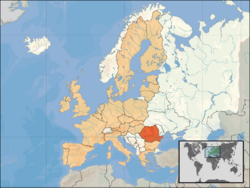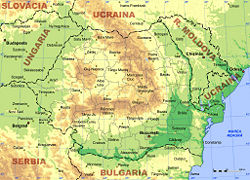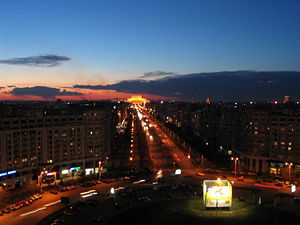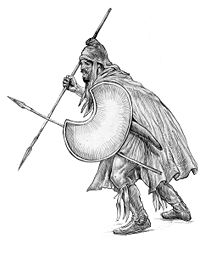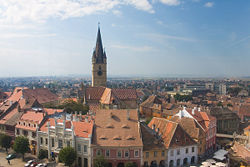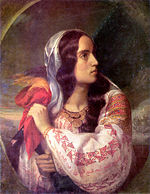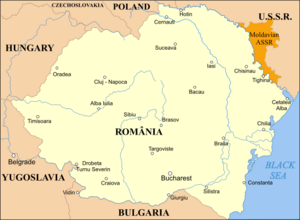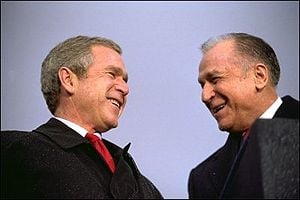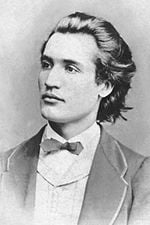Difference between revisions of "Romania" - New World Encyclopedia
Mike Butler (talk | contribs) m |
Mike Butler (talk | contribs) (Romania - politics) |
||
| Line 188: | Line 188: | ||
==Government and politics== | ==Government and politics== | ||
| − | + | [[Image:BucharestParliament2007 03 10b.JPG|thumb|right|300px|The Palace of the Parliament, the seat of the Romania's bicameral parliament ([[:Image:Lamppost bgiu.jpg|Closeup]] of the lights in front)]] | |
| − | [[Image:BucharestParliament2007 03 10b.JPG|thumb| | + | Romania is a semi-presidential democratic republic where executive functions are shared between the president and the prime minister. The president is elected by popular vote, and resides at Cotroceni Palace. Since the constitutional amendment of 2003, the president's term is five years (previously it was four). |
| − | Romania is a | ||
| − | + | A prime minister, who appoints the other members of his or her cabinet, and who is nearly always the head of the party or coalition that holds a majority in the parliament, heads the Romanian Government, which is based at Victoria Palace. If no party holds 50 percent + 1 of the total seats in parliament, the president will appoint the prime minister. Before beginning its term, the government is subject to a parliamentary vote of approval. | |
| − | The | + | The legislative branch of the government, collectively known as the bicameral parliament of Romania (''Parlamentul României''), consists of two chambers – the Senate (''Senat''), which has 137 members, and the Chamber of Deputies (''Camera Deputaţilor''), which has 332 members. The members of both chambers are elected every four years under a system of party-list proportional representation. All aged 18 years of age and over may vote. |
| − | The | + | The justice system is independent of the other branches of government, and is made up of a hierarchical system of courts culminating in the High Court of Cassation and Justice, which is the supreme court of Romania. There are also courts of appeal, county courts and local courts. The Romanian judicial system is strongly influenced by the French model, considering that it is based on civil law and is inquisitorial in nature. The Constitutional Court (''Curtea Constituţională'') is responsible for judging the compliance of laws and other state regulations to the Romanian Constitution, which is the fundamental law of the country. The constitution, which was introduced in 1991, can only be amended by a public referendum; the last amendment was in 2003. The Romanian Constitutional Court structure is based on the Constitutional Council of France, being made up of nine judges who serve nine-year, non-renewable terms. Following the 2003 constitutional amendment, the court's decisions cannot be overruled by any majority of the parliament. |
| − | |||
| − | ==Counties== | + | The country's entry into the [[European Union]] in 2007 has been a significant influence on its domestic policy. As part of the process, Romania has instituted reforms including judicial reform, increased judicial cooperation with other member states, and measures to combat corruption. |
| − | + | ||
| − | [[Image:Romania counties.png|thumb|250px|Administrative map of Romania outlining the | + | ===Counties=== |
| − | Romania is divided into | + | [[Image:Romania counties.png|thumb|250px|Administrative map of Romania outlining the 41 counties]]. The map also shows the historical region of Transylvania in green, Wallachia in blue, Moldavia in red, and Dobrogea in yellow.]] |
| − | + | Romania is divided into 41 counties]] (judeţe), as well as the municipality of [[Bucharest]] (Bucureşti), which is its own administrative unit. Each county is administered by a county council (''consiliu judeţean''), responsible for local affairs, as well as a prefect, who is appointed by the central government but cannot be a member of any political party. | |
| − | + | ||
| − | + | ||
| − | + | Alongside the county structure, Romania is also divided into eight development regions, which correspond to divisions in the European Union, but which have no administrative capacity and are instead used for co-ordinating regional development projects and statistical purposes. The country is further subdivided into 2686 communes, which are rural localities, and 265 towns. Communes and towns have their own local councils and are headed by a mayor (''primar''). Larger and more urbanised towns gain the status of [[Municipalities of Romania|municipality]], which gives them greater administrative power over local affairs. | |
| − | + | ||
| − | + | Romania joined [[NATO]] on [[March 29]], [[2004]], and the [[European Union]] (EU) on [[January 1]] [[2007]]. | |
| − | |||
| − | |||
| − | |||
| − | |||
| − | |||
| − | |||
| − | |||
| − | |||
| − | |||
| − | |||
| − | |||
| − | |||
| − | |||
| − | |||
| − | |||
| − | |||
| − | |||
| − | |||
| − | |||
| − | |||
| − | |||
| − | |||
| − | |||
| − | |||
| − | |||
| − | |||
| − | |||
| − | |||
| − | |||
| − | |||
| − | |||
| − | |||
| − | |||
| − | |||
| − | |||
| − | |||
| − | |||
| − | |||
| − | |||
| − | |||
| − | |||
| − | |||
| − | |||
==Economy== | ==Economy== | ||
Revision as of 05:11, 10 July 2007
| România Romania | |||||
| |||||
| Motto: (each main institution has its own motto) | |||||
| Anthem: Deşteaptă-te, române! | |||||
|
Location of Romania (orange)
– on the European continent (camel white) – in the European Union (camel) [Legend] | |||||
| Capital | Bucharest (Bucureşti) 44°25′N 26°06′E | ||||
|---|---|---|---|---|---|
| Largest city | capital | ||||
| Official languages | Romanian1 | ||||
| Government | Semi-presidential Unitary Democratic Republic | ||||
| - President | Traian Băsescu | ||||
| - Prime Minister | Călin Popescu-Tăriceanu | ||||
| Independence | |||||
| - Declared | 9 May 1877 (O.S.)2 | ||||
| - Recognised | 13 July 18783 | ||||
| Accession to EU | January 1 2007 | ||||
| Area | |||||
| - Total | 238,392 km² (82nd) 92,043 sq mi | ||||
| - Water (%) | 3 | ||||
| Population | |||||
| - July 2007 estimate | 22,276,056 | ||||
| - 2002 census | 21,680,974 | ||||
| - Density | 91/km² 236/sq mi | ||||
| GDP (PPP) | 2007 estimate | ||||
| - Total | $229.9 billion | ||||
| - Per capita | $10,661[1] | ||||
| HDI (2004) | |||||
| Currency | Leu (RON)
| ||||
| Time zone | EET (UTC+2) | ||||
| - Summer (DST) | EEST (UTC+3) | ||||
| Internet TLD | .ro4 | ||||
| Calling code | +40 | ||||
| 1 Other languages, such as Hungarian, German, Romani, Ukrainian and Serbian, are official at various local levels. 2 Romanian War of Independence. 3 Treaty of Berlin. 4 The .eu domain is also used, as it is shared with other European Union member states. | |||||
Romania (Romanian: România, IPA: [ro.mɨˈni.a]) is a country in Southeastern Europe bordering Hungary and Serbia to the west, Ukraine and Moldova to the northeast, and Bulgaria to the south.
The modern state of Romania was formed by the merging of the Danubian Principalities of Moldavia and Wallachia in 1859.The state united with Transylvania in 1918.
Many Romanians take pride in being the most eastern Romance people, completely surrounded by non-Latin peoples ("a Latin island in a Slavic sea").
Geography
The name of Romania comes from Român (Romanian) which is a derivative of the word Romanus ("Roman]]") from Latin. Before the nineteenth century, Romanian documents use interchangeably two spelling forms: Român and Rumân The name "România" as common homeland of all Romanians is documented in the early nineteenth century.
With a surface area of 92,043 square miles (238,391 km²), Romania is the largest country in southeastern Europe and the 12th-largest in Europe, or slightly smaller than Oregon in the United States. Situated in the northeastern portion of the Balkan Peninsula, the country is halfway between the equator and the North Pole and equidistant from the westernmost part of Europe—the Atlantic Coast—and the most easterly—the Ural Mountains.
The Danube river forms a large part of Romania's border with Serbia and Bulgaria, is joined by the Prut River, which forms the border with the Republic of Moldova, and flows into the Black Sea on Romanian territory, forming the Danube Delta, the largest delta in Europe, which is a biosphere reserve and World Heritage-listed site due to its biodiversity. Other significant rivers are the Siret, running vertically through Moldavia, the Olt, running from the oriental Carpathian Mountains to Oltenia, the Tisa, marking a part of the border between Romania and Hungary, the Mureş, running through Transylvania from East to West, and the Someş.
The Danube is an important water route for domestic shipping, as well as international trade. It is navigable for river vessels along its entire Romanian course and for seagoing ships as far as the port of Brăila. It is also important for the production of hydroelectric power, at one of Europe's largest hydroelectric stations located at the Iron Gates, where the Danube surges through the Carpathian gorges.
Romania's terrain is distributed roughly equally between mountainous, hilly and lowland territories. The Carpathian Mountains dominate the centre of Romania, with 14 of its peaks reaching above the altitude of 6500 feet (2000 metres). The highest mountain in Romania is Moldoveanu Peak at 8346 feet (2544 meters). In south-central Romania, the Carpathians soften into hills, towards the Bărăgan Plains.
Because of its position on the south-eastern portion of the European continent, Romania has a climate that is transitional between temperate and continental. In the extreme southeast, Mediterranean influences offer a milder, maritime climate. In Bucharest, the temperature ranges from -20.2°F (-29°C) in January to 84.2°F (29°C) in July. Rainfall, although adequate throughout the country, decreases from west to east and from mountains to plains. Some mountainous areas receive about 40 inches (1010 millimeters) of precipitation each year. Annual precipitation averages about 25 inches (635mm), in central Transylvania, and only 15 inches (381 millimeters) at Constanţa on the Black Sea.
Romania has a stretch of coast along the Black Sea, and the eastern and southern Carpathian Mountains run through its center.
Romania's geographical diversity has led to an accompanying diversity of flora and fauna. The country has the largest brown bear population in Europe, while chamois are also known to live in the Carpathian Mountains, which dominate the centre of Romania.
Natural resources include petroleum (reserves declining), timber, natural gas, coal, iron ore, salt, arable land, and hydro power.
Natural hazards include earthquakes, which are most severe in south and southwest. The geological structure and climate results in numerous landslides.
Its capital and largest city is Bucharest, which with 2,082,334 inhabitants, is the sixth largest city in the European Union. Located in the southeast of the country, it is the industrial and commercial centre of Romania. Since 1459, it has gone through a variety of changes, becoming the state capital of Romania in 1862 and steadily consolidating its position as the centre of the Romanian mass media, culture and arts. Its eclectic architecture is a mix of historical, interbellum, Communist-era and modern. In the period between the two World Wars, the city's elegant architecture and the sophistication of its elite earned Bucharest the nickname of the "Paris of the East" or "Little Paris". Other cities are: Iaşi with 320,888, Cluj-Napoca with 318,027, Timişoara with 317,660, and Constanţa with 310,471.
History
The territory of Romania has been inhabited by different groups of people since prehistory. In 2002, the oldest modern human (Homo sapiens sapiens) remains in Europe, were discovered in a cave Anina, Romania. Nicknamed "John of Anina", his remains (the lower jaw) are approximately 42,000 years old.
Dacians
The territory of today's Romania was inhabited since at least 513 B.C.E. by the Getae or Dacians, a Thracian tribe. Under the leadership of Burebista (70-44 B.C.E.) the Dacians became a powerful state which threatened even the regional interests of the Romans. Julius Caesar intended to start a campaign against the Dacians, but was assassinated in 44 B.C.E. A few months later, Burebista shared the same fate, assassinated by his own noblemen. His powerful state was divided in four and did not become unified again until 95 B.C.E., under the reign of the Dacian king Decebalus. The Dacian state sustained a series of conflicts with the expanding Roman Empire, and was finally conquered in 106 C.E. by the Roman emperor Trajan, who defeated Decebalus.
The Gothic and Carpian campaigns in the Balkans during 238–269 C.E. (from the beginning of the period of military anarchy to the battle of Naissus), forced the Roman Empire to reorganize a new Roman province of Dacia south of the Danube, inside former Moesia Superior. In either 271 or 275 C.E., the Roman army and administration left Dacia, which was invaded by the Goths.
Dark Ages
The Goths lived with the local people until 378 C.E., when another nomadic people, the Huns, arrived and stayed until 435. The Gepids and the Eurasian Avars ruled Transylvania until the eighth century]], after which the Bulgarians included the territory of modern Romania in the First Bulgarian Empire until 1018.
Middle Ages
Many small local states with varying degree of independence developed, but only in the fourteenth century the larger principalities of Moldavia and Wallachia emerged to fight the Ottoman Turks, who conquered Constantinople in 1453. By 1541, the entire Balkan peninsula and most of Hungary became Ottoman provinces. In contrast, Moldavia, Wallachia, and Transylvania, came under Ottoman suzerainty, but conserved fully internal autonomy and, until the eighteenth century, some external independence.
By the eleventh century, the area of today's Transylvania became a largely autonomous part of the Kingdom of Hungary. Hungarian rulers invited the Székely, the Teutonic Order and the Transylvanian Saxons to settle in Transylvania. The Romanian principality of Wallachia was founded by Basarab I during the thirteenth century, and Moldavia by Dragoş during the fourteenth century. In 1475, Stephen III ("the Great")]] of Moldavia scored a decisive victory against the Ottoman Empire at the Battle of Vaslui. But Wallachia came under the suzerainty of the Ottoman Empire in 1476, and Moldavia in 1514. In 1541, Transylvania became a multi-ethnic principality under the suzerainty of the Ottoman Empire following the Battle of Mohács. Michael the Brave (1558-9 August 1601) was the Prince of Wallachia (1593-1601), of Transylvania (1599-1600), and of Moldavia (1600). During his reign the three principalities largely inhabited by Romanians were for the first time united under a single rule. But the chance for a unity dissolved after Michael was killed, only one year later, by the soldiers of a Habsburg (Austrian) army general Giorgio Basta.
Early Modern Romania
Several competing theories have been generated to explain the origin of modern Romanians. Linguistic and geo-historical analyses tend to indicate that Romanians have coalesced as a major ethnic group both south and north of the Danube. In 1699 Transylvania became a territory of the Habsburg's Austrian empire, following the Austrian victory over the Turks. The Austrians, in their turn, rapidly expanded their empire: in 1718 an important part of Wallachia, called Oltenia, was incorporated to the Austrian monarchy and was only returned in 1739.
In 1775, the Habsburg Monarchy annexed the northern part of Moldova, Bukovina, and the Ottoman Empire its south-eastern part, Budjak. In 1812 the Russian Empire annexed its eastern half, Bessarabia.
National awakening
As in most European countries, 1848 brought revolution to Moldavia, Wallachia, and Transylvania, announced by Tudor Vladimirescu and his Pandurs in the Wallachian uprising of 1821. The goals of the revolutionaries - complete independence for Moldavia and Wallachia, and national emancipation in Transylvania - remained unfulfilled, but were the basis of the subsequent evolutions. Also, the uprising helped the population of the three principalities recognise their unity of language and interests.
Heavily taxed and badly administered under the Ottoman Empire, in 1859, people in both Moldavia and Wallachia elected the same domnitor (ruler) - Alexander John Cuza - as prince. Cuza led an agricultural reform distributing land to poor and attracting enemies. Via a 1866 coup d'etat, also known as the Abominable Revolution, Cuza was exiled and replaced by Prince Karl of Hohenzollern-Sigmaringen, who became known as Prince Carol I of the Principality of Romania.
The old kingdom
In 1877, Romania declared independence from the Ottoman Empire and, following a Russian-Romanian-Turkish war, in which Romania fought on the Russian side, Romania’s independence was recognized by the Treaty of Berlin, 1878, making it the first independent national state in the eastern half of Europe. In return for ceding to Russia the three southern districts of Bessarabia that had been regained by Moldavia after the Crimean War in 1852, the Kingdom of Romania acquired Dobruja. On March 26, 1881, the principality was raised to a monarchy and Prince Carol became King Carol I. The new state, squeezed between the great powers of the Ottoman, Austro-Hungarian, and Russian empires, looked to the West, particularly France, for its cultural, educational, military and administrative models.
At the end of the nineteenth century, the Habsburg Monarchy incorporated Transylvania into what later became the Austrian Empire. During the period of the dual monarchy of Austria-Hungary (1867-1918), Romanians in Transylvania experienced a period of severe oppression under the Magyarization policies of the Hungarian government.
World War I
In 1916 Romania entered World War I on the Allies (Entente) of World War I side, after the Entente countries agreed to recognize Romanian rights over Transylvania, which at that time was part of Austria-Hungary. The Romanian military campaign ended in disaster as the Central Powers conquered most of the country and captured or killed the majority of its army within four months. Bucharest, and two-thirds of the country occupied by the Central Powers. In May 1918, Romania was in no position of continue the war, and negotiated a peace treaty (Treaty of Bucharest) with Germany. In October 1918, Romania joined the war again. By the end of the war, the Austro-Hungarian and Russian empires had disintegrated; governing bodies created by the Romanians of Transylvania, Bessarabia and Bukovina chose union with the Kingdom of Romania, resulting in Greater Romania.
Greater Romania
The Romanian expression România Mare (literal translation "Great Romania", but more commonly rendered "Greater Romania") generally refers to the Romanian state in the years between the First and Second World Wars and, by extension, to the territory Romania covered at the time (see the map). Romania achieved at that time its greatest territorial extent, managing to unite all the historic Romanian lands (which were also inhabited by a majority of Romanians). Historically, Greater Romania—România Mare—represented one of the ideals of Romanian nationalism. Greater Romania is still seen by many as a "paradise lost", often by comparison with the "stunted" Communist Romania. To exploit the nationalistic connotation of the term, a Greater Romania nationalist political party uses it as its name.
In 1918, at the end of World War I, Transylvania and Bessarabia united with the Romanian Old Kingdom. Transylvania united by the Proclamation of Union voted by the Deputies of the Romanians from Transylvania; Bessarabia, having declared its independence from Russia in 1917 by the Conference of the Country, called in Romanian troops to protect the province from the Bolsheviks who were spreading the Russian Revolution. The union of the regions of Transylvania, Maramureş, Crişana and Banat with the Old Kingdom of Romania was ratified in 1920 by the Treaty of Trianon, which recognised the sovereignty of Romania over these regions and settled the border between the independent Republic of Hungary and the Kingdom of Romania. The union of Bucovina and Bessarabia with Romania was ratified in 1920 by the Treaty of Versailles. Romania had also recently acquired the Southern Dobruja territory called "The Quadrilateral" from Bulgaria as a result of its participation in the Second Balkan War in 1913.
The union of 1918 also led to the inclusion of various sizable minorities, including Magyars (ethnic Hungarians), Germans, Jews, Ukrainians, Bulgarians, with a total of about 28 percent of the population.
From 1918 to 1938, Romania was a liberal constitutional monarchy, but one facing the rise of the nationalistic, anti-semitic parties, particularly Iron Guard, which earned about 15 percent of the votes in the general elections of 1937. From 1938 to 1944, Romania was a dictatorship. The first dictator was King Carol II himself, who abolished the parliamentary regime and ruled with his camarilla.
World War II
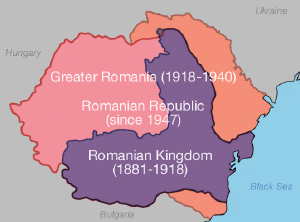
In 1939, Germany and the Soviet Union signed the Molotov-Ribbentrop Pact, which stipulated, amongst other things, the Soviet "interest" in Bessarabia. In 1940, Romania lost territory in both east and west: In June 1940, after issuing an ultimatum to Romania, the Soviet Union occupied Bessarabia and northern Bukovina . Two thirds of Bessarabia were combined with a small part of the USSR to form the Moldavian SSR. Northern Bukovina and Budjak were apportioned to the Ukrainian SSR. In August 1940, Northern Transylvania was awarded to Hungary by Germany and Italy through the Second Vienna Award.
As a result of Carol II's having lost so much territory through failed diplomacy, General Ion Antonescu was supported by the army to seize the leadership of Romania. Carol was forced to abdicate, replaced as king by his son Mihai of Romania. Southern Dobruja was also lost to Bulgaria shortly after Carol's abdication. For four months (the period of the National Legionary State) he had to share power with the Iron Guard, but the latter overplayed their hand in January 1941 and were suppressed.
Romania entered World War II under the command of the German Wehrmacht in June 1941, declaring war to the Soviet Union in order to recover Bessarabia and northern Bukovina. Romania was awarded the territory between Dniester and the Southern Bug by Germany to administer it under the name Transnistria.
According to an international commission report released by the Romanian government in 2004, Antonescu's Fascist government of Romania is responsible for the murder in various forms (including deportations to concentration camps and executions by the Romanian Army and Gendarmerie]] and the German Einsatzgruppen), between 280,000 to 380,000 Jews in Romania and in the war zone of Bessarabia, Bukovina and Transnistria.
In August 1944, a coup led by King Mihai, with support from opposition politicians and the army, deposed the Antonescu dictatorship and put Romania's armies under Red Army command. Romania suffered additional heavy casualties fighting the Nazi Army in Hungary and Czechoslovakia.
The Paris Peace Treaty at the end of World War II rendered the Vienna Awards void: Northern Transylvania returned to Romania—having, for several years, an autonomous status that was eventually abolished—but Bessarabia, northern Bukovina and southern Dobruja were not recovered. The Moldavian SSR became independent of the Soviet Union only with the latter's 1991 demise, becoming the Republic of Moldova.
Soviet rule
With the Red Army forces still stationed in the country and exerting de facto control, Communists and their allied parties claimed 90 percent of the vote, through a combination of vote manipulation, elimination and forced mergers of competing parties, establishing themselves as the dominant force. In 1947, King Michael I was forced by the Communists to abdicate and leave the country. Romania was proclaimed a republic, and remained under direct military and economic control of the USSR until the late 1950s. During this period, Romania's resources were drained by the "SovRom" agreements: mixed Soviet-Romanian companies established to mask the looting of Romania by the Soviet Union, in addition to excessive war reparations paid to the USSR. A large number of people were arbitrarily imprisoned for political, economic or unknown reasons: detainees in prisons or camps, deported, persons under house arrest, and administrative detainees. Political prisoners were also detained as psychiatric patients. Estimations vary, from 60,000, 80,000, up to two million. There were hundreds of thousands of abuses, deaths and incidents of torture against a large range of people, from political opponents to ordinary citizens. Most political prisoners were freed in a series of amnesties between 1962 and 1964. Soviet troops left in 1958.
Ceauşescu regime
Nicolae Ceauşescu (1918–1989) became general secretary in 1965, and head of state in 1967. From 1958, Romania started to pursue independent policies, including the condemnation of the Soviet-led 1968 invasion of Czechoslovakia (Romania was the only Warsaw Pact country not to take part in the invasion), the continuation of diplomatic relations with Israel after the Six-Day War of 1967 (again, the only Warsaw Pact country to do so), the establishment of economic (1963) and diplomatic (1967) relations with the Federal Republic of Germany, and so forth. Also, close ties with the Arab countries (and the PLO) allowed Romania to play a key role in the Israel-Egypt and Israel-PLO peace processes (intermediated the visit of Sadat in Israel. A short-lived period of relative economic well-being and openness followed in the late 1960s and the beginning of the 1970s.
Ceauşescu's denunciation of the 1968 Soviet invasion of Czechoslovakia and a brief relaxation in internal repression helped give him a positive image both at home and in the West. Seduced by Ceauşescu's "independent" foreign policy, Western leaders were slow to turn against a regime that, by the late 1970s, had become increasingly harsh, arbitrary, and capricious.
As Romania's foreign debt sharply increased between 1977 and 1981 (from three to 10 billion US dollars), the influence of international financial organisations such as the International Monetary Fund or the World Bank grew, conflicting with Nicolae Ceauşescu's autarchic policies. Ceauşescu eventually initiated a project of total reimbursement of the foreign debt (completed in 1989, shortly before his overthrow). To achieve this goal, he imposed policies that impoverished Romanians and exhausted the Romanian economy. He profoundly deepened Romania's police state and imposed a cult of personality.
The Romanian Revolution of 1989 resulted in more than 1000 deaths in Timişoara and Bucharest, and brought about the fall of Ceauşescu and the end of the Communist regime in Romania. After a weeklong state of unrest in Timişoara, a mass rally summoned in Bucharest in support of Ceauşescu on December 21, 1989, turned hostile. The Ceauşescu couple, fleeing Bucharest by helicopter, ended up in the custody of the army; after being tried and convicted by a kangaroo court for "genocide" and other crimes, they were executed on December 25, 1989. The events of this revolution remain a matter of debate, with many conflicting theories as to the motivations and even actions of some of the main players.
Romania since 1989
Ion Iliescu, a former Communist Party official marginalized by Ceauşescu, attained national recognition as the leader of an impromptu governing coalition, the National Salvation Front (FSN) that proclaimed the restoration of democracy and civil liberties on December 22, 1989. Iliescu initially outlawed the Communist Party, but he soon revoked that decision. However, Ceauşescu's most unpopular measures, such as bans on abortion and contraception, were among the first laws to be changed after the revolution, and their legality has not been questioned since then.
Presidential and parliamentary elections were held on May 20, 1990. Running against representatives of the re-established pre-war National Peasants' Party and National Liberal Party, and taking advantage of FSN's tight control of the national radio and television, Iliescu won 85 percent of the vote, and secured two-thirds of the seats in Parliament. A university professor with strong family roots in the Communist Party, Petre Roman, was named prime minister of the new government, which consisted mainly of former communist officials. The government initiated modest free market reforms.
Because the majority of ministers in the Petre Roman government were ex-communists, anti-communist protesters initiated Golaniad around-the-clock anti-government demonstration in University Square, Bucharest, in April 1990. Two months later, these protesters, whom the government referred to as "hooligans", were brutally dispersed by the miners from Jiu Valley, called in by President Iliescu; this event became known as the mineriad. The miners also attacked the headquarters and private residences of opposition leaders. Petre Roman's government fell in late September 1991, when the miners returned to Bucharest to demand higher salaries. A technocrat, Theodor Stolojan, was appointed to head an interim government until new elections could be held.
In December 1991, a new constitution was drafted and subsequently adopted, after a popular referendum, which, however, attracted criticism from international observers who accused the government of manipulating the population and even of outright fraud. (The constitution was most recently revised by a national referendum on October 18-19, 2003, again plagued by fraud accusations made by internal and international observers.) The new constitution, which took effect October 29, 2003, follows the structure of the Constitution of 1991, but makes significant revisions, among which the most significant are extension of the presidential mandate from four years to five, and the guaranteed protection of private property.
The subsequent disintegration of the FSN produced several political parties including the Democratic Party (PD), the Romanian Democrat Social Party (PDSR, later Social Democratic Party, PSD), and the ApR (Alliance for Romania). The Socialist parties that emerged from the National Salvation Front (FSN) governed Romania from 1990 until 1996 through several coalitions and governments with Ion Iliescu as head of state. Since then there have been three democratic changes of government: in 1996, the democratic-liberal opposition and its leader Emil Constantinescu acceded to power; in 2000 the Social Democrats returned to power, with Iliescu once again president; and in 2004 Traian Băsescu was elected president, with an electoral coalition called Justice and Truth Alliance (DA). The government was formed by a larger coalition which also includes the Conservative Party and the ethnic Hungarian party.
Post-Cold War Romania developed closer ties with Western Europe, eventually joining NATO in 2004. The country applied in June 1993 for membership in the European Union (EU). It became an Associated State of the EU in 1995, an Acceding Country in 2004, and a member on January 1, 2007.
Government and politics
Romania is a semi-presidential democratic republic where executive functions are shared between the president and the prime minister. The president is elected by popular vote, and resides at Cotroceni Palace. Since the constitutional amendment of 2003, the president's term is five years (previously it was four).
A prime minister, who appoints the other members of his or her cabinet, and who is nearly always the head of the party or coalition that holds a majority in the parliament, heads the Romanian Government, which is based at Victoria Palace. If no party holds 50 percent + 1 of the total seats in parliament, the president will appoint the prime minister. Before beginning its term, the government is subject to a parliamentary vote of approval.
The legislative branch of the government, collectively known as the bicameral parliament of Romania (Parlamentul României), consists of two chambers – the Senate (Senat), which has 137 members, and the Chamber of Deputies (Camera Deputaţilor), which has 332 members. The members of both chambers are elected every four years under a system of party-list proportional representation. All aged 18 years of age and over may vote.
The justice system is independent of the other branches of government, and is made up of a hierarchical system of courts culminating in the High Court of Cassation and Justice, which is the supreme court of Romania. There are also courts of appeal, county courts and local courts. The Romanian judicial system is strongly influenced by the French model, considering that it is based on civil law and is inquisitorial in nature. The Constitutional Court (Curtea Constituţională) is responsible for judging the compliance of laws and other state regulations to the Romanian Constitution, which is the fundamental law of the country. The constitution, which was introduced in 1991, can only be amended by a public referendum; the last amendment was in 2003. The Romanian Constitutional Court structure is based on the Constitutional Council of France, being made up of nine judges who serve nine-year, non-renewable terms. Following the 2003 constitutional amendment, the court's decisions cannot be overruled by any majority of the parliament.
The country's entry into the European Union in 2007 has been a significant influence on its domestic policy. As part of the process, Romania has instituted reforms including judicial reform, increased judicial cooperation with other member states, and measures to combat corruption.
Counties
. The map also shows the historical region of Transylvania in green, Wallachia in blue, Moldavia in red, and Dobrogea in yellow.]]
Romania is divided into 41 counties]] (judeţe), as well as the municipality of Bucharest (Bucureşti), which is its own administrative unit. Each county is administered by a county council (consiliu judeţean), responsible for local affairs, as well as a prefect, who is appointed by the central government but cannot be a member of any political party.
Alongside the county structure, Romania is also divided into eight development regions, which correspond to divisions in the European Union, but which have no administrative capacity and are instead used for co-ordinating regional development projects and statistical purposes. The country is further subdivided into 2686 communes, which are rural localities, and 265 towns. Communes and towns have their own local councils and are headed by a mayor (primar). Larger and more urbanised towns gain the status of municipality, which gives them greater administrative power over local affairs.
Romania joined NATO on March 29, 2004, and the European Union (EU) on January 1 2007.
Economy
With a GDP per capita (PPP) of $10,661[2] estimated for 2007, Romania is considered an upper-middle income economy[3] and has been part of the European Union since 1 January 2007. After the Communist regime was overthrown in late 1989, the country experienced a decade of economic instability and decline, led in part by an obsolete industrial base and a lack of structural reform. From 2000 onwards, however, the Romanian economy was transformed into one of relative macroeconomic stability, characterised by high growth, low unemployment and declining inflation. In 2006, according to the Romanian Statistics Office, GDP growth was recorded at 7.7%, one of the highest rates in Europe.[4] Unemployment in Romania was at 4.5% in April 2007[5] which is very low compared to other middle-sized or large European countries such as Poland, France, Germany and Spain. Foreign debt is also comparatively low, at 20.3% of GDP.[6] Exports have increased substantially in the past few years, with a 25% year-on-year rise in exports in the first quarter of 2006. Romania's main exports are clothing and textiles, industrial machinery, electrical and electronic equipment, metallurgic products, raw materials, cars, military equipment, software, pharmaceuticals, fine chemicals, and agricultural products (fruits, vegetables, and flowers). Trade is mostly centred on the member states of the European Union, with Germany and Italy being the country's single largest trading partners. The country, however, maintains a large trade deficit, as it imports 37% more goods than it exports.
After a series of privatisations and reforms in the late 1990s and early 2000s, government intervention in the Romanian economy is somewhat lower than in other European economies.[7] In 2005, the liberal-democrat Tăriceanu government replaced Romania's progressive tax system with a flat tax of 16% for both personal income and corporate profit, resulting in the country having the lowest fiscal burden in the European Union,[8] a factor which has contributed to the growth of the private sector. The economy is predominantly based on services, which account for 55% of GDP, even though industry and agriculture also have significant contributions, making up 35% and 10% of GDP, respectively. Additionally, 32% of the Romanian population is employed in agriculture and primary production, one of the highest rates in Europe.[6] Since 2000, Romania has attracted increasing amounts of foreign investment, becoming the single largest investment destination in Southeastern and Central Europe. Foreign direct investment was valued at €8.3 billion in 2006.[9] According to a 2006 World Bank report, Romania currently ranks 49th out of 175 economies in the ease of doing business, scoring higher than other countries in the region such as Hungary, Poland and the Czech Republic.[10] Additionally, the same study judged it to be the world's second-fastest economic reformer in 2006.[11] The average gross wage per month in Romania is 1387 lei as of April 2007,[12] equating to €443.13 (US$600.17) based on international exchange rates and $827.57 based on purchasing power parity.[13] 88% of all Romanian citizens have a color television set in their household and 90% a refrigerator.[14]
Demographics
According to the 2002 census, Romania has a population of 21,680,974 and, similarly to other countries in the region, is expected to gently decline in the coming years as a result of sub-replacement fertility rates. Romanians make up 89.5% of the population. The largest ethnic minorities are Hungarians, who make up 6.6% of the population and Roma, who make up 2% - 9% of the population. By the official census 409,000, by the estimations 1,500,000-2,000,000 Roma live in Romania.[1] Hungarians, who are a sizeable minority in Transylvania, constitute a majority in the counties of Harghita and Covasna. Ukrainians, Germans, Lipovans, Turks, Tatars, Serbs, Slovaks, Bulgarians, Croats, Greeks, Jews, Czechs, Poles, Italians, Chinese, Armenians, as well as other ethnic groups, account for the remaining 1.4% of the population.[15] The population density of the country as a whole has doubled since 1900 although, in contrast to other central European states, there is still considerable room for further growth. The overall density figures, however, conceal considerable regional variation. Population densities are naturally highest in the towns, with the plains (up to altitudes of some 700 feet) having the next highest density, especially in areas with intensive agriculture or a traditionally high birth rate (e.g., northern Moldavia and the “contact” zone with the Subcarpathians); areas at altitudes of 700 to 2,000 feet, rich in mineral resources, orchards, vineyards, and pastures, support the lowest densities.
The official language of Romania is Romanian, an Eastern Romance language related to French, Spanish, Catalan, Italian and Portuguese. Romanian is spoken as a first language by 91% of the population, with Hungarian and Romani being the most important minority languages, spoken by 6.7% and 1.1% of the population, respectively.[15] Until the 1990s, there was also a substantial number of German-speaking Transylvanian Saxons, even though many have since emigrated to Germany, leaving only 45,000 native German speakers in Romania. In localities where a given ethnic minority makes up more than 20% of the population, that minority's language can be used in the public administration and justice system, while native-language education and signage is also provided. English and French are the main foreign languages taught in schools. English is spoken by 5 million Romanians, French is spoken by 4-5 million, and German, Italian and Spanish are each spoken by 1-2 million people.[16] Historically, French was the predominant foreign language spoken in Romania, even though English has since superseded it. Consequently, Romanian English-speakers tend to be younger than Romanian French-speakers. Romania is, however, a full member of La Francophonie, and hosted the Francophonie Summit in 2006. German has been taught predominantly especially in Transylvania, due to traditions tracing back to the Austro-Hungarian rule in this province.[citation needed]
Romania is a secular state, thus having no national religion. The dominant religious body is the Romanian Orthodox Church; its members make up 86.7% of the population according to the 2002 census. Other important religions include Roman Catholicism (4.7%), Protestantism (3.7%), Pentecostal denominations (1.5%) and the Romanian Greek-Catholic Church (0.9%).[15] Romania also has a historically significant Muslim minority concentrated in Dobrogea, who are mostly of Turkish ethnicity and number 67,500 people. [2] Based on the 2002 census data, there are also 6,179 Jews, 23,105 people who are of no religion and/or atheist, and 11,734 who refused to answer. On December 27, 2006, President Traian Băsescu approved a new Law on Religion; under the new legislation, religious denominations can only receive official registration if they have at least 20,000 members, or about 0.1 percent of Romania's total population.[17]
The largest Romanian cities are: Bucharest (Bucureşti) with 2,082,334 inhabitants, Iaşi with 320,888, Cluj-Napoca with 318,027, Timişoara with 317,660, and Constanţa with 310,471.[18]
National holidays
The Christian holidays of Christmas and (Orthodox) Easter are celebrated (they are official, non-working, holidays). Unlike some other Eastern Orthodox Churches, the Romanian Orthodox Church celebrates Christmas on 25 December; however, they follow the usual Eastern Orthodox practice for the date of Easter. Other official holidays (non-working) are New Year's Day (January 1), Labour Day (May 1), and the National Day of Romania (December 1, the Union Day). For Christmas and for Labour Day, it is common for businesses to shut down more than a single day.
Minor, but widely observed, holidays include Mărţişor (March 1), marking the start of spring, Dragobete (February 24), day of lovers, and International Women's Day (March 8). Some businesses give women employees the day off for International Women's Day. Some holidays celebrated in the United States or in other parts of Europe have recently been gaining some currency in Romania, for example Valentine's Day (February 14).
Culture
The culture of Romania is rich and varied. Like Romanians themselves, it is fundamentally defined as the meeting point of three regions: Central Europe, Eastern Europe, and the Balkans, but cannot be fully included in any of them. The Romanian identity formed on a substratum of mixed Roman and quite possibly Dacian elements (although the latter is controversial), with many other influences. During late Antiquity and the Middle Ages, the major influences came from the Slavic peoples who migrated and settled in nearby Bulgaria, Serbia, Ukraine and eventually Russia; from medieval Greeks and the Byzantine Empire; from a long domination by the Ottoman Empire; from the Hungarians; and from the Germans living in Transylvania. Modern Romanian culture emerged and developed over roughly the last 250 years under a strong influence from Western culture, particularly French and German culture.
Literature
The older classics of Romanian literature remain very little known outside Romania. Mihai Eminescu, a famous 19th century Romanian poet is still very much loved in Romania (especially his poems), along with several other "true classics" like George Coşbuc and Tudor Arghezi. The revolutionary year 1848 had its echoes in the Romanian principalities and in Transylvania, and a new elite from the middle of the 19th century emerged from the revolutions: Mihail Kogălniceanu (writer, politician and the first prime minister of Romania), Vasile Alecsandri (politician, playwright and poet), Andrei Mureşanu (publicist and the writer of the current Romanian National Anthem) and Nicolae Bălcescu (historian, writer and revolutionary). Other classic Romanian writers whose works are still widely read in their native country are playwright Ion Luca Caragiale (the National Theatre Bucharest is officially named in his honor) and Ion Creangă (best known for his children's stories). The works of composer George Enescu are well-known to Romanians, many of whom consider him their national musician. The symphony orchestra of Bucharest is named in Enescu's honor. Romanian literature has recently gained some renown outside the borders of Romania (mostly through translations into German, French and English). Some modern Romanian authors became increasingly popular in Germany, France and Italy, especially Eugen Ionescu, Mircea Eliade, Emil Cioran, Tristan Tzara and Mircea Cărtărescu.
Architecture
The UNESCO List of World Heritage Sites includes Romanian sites such as the Saxon villages with fortified churches in Transylvania, the Painted churches of northern Moldavia with their fine exterior and interior frescoes, the Wooden Churches of Maramures unique examples that combine Gothic style with traditional timber construction, the citadel of Sighişoara and the Dacian Fortresses of the Orăştie Mountains. Also, in 2007, the city of Sibiu is the European Capital of Culture alongside the city of Luxembourg.
Media and television
Reporters Without Borders ranks Romania 58th in its Worldwide Press Freedom Index, the same level as Poland and Hong-Kong.[19] The public television company Televiziunea Română and the public radio Societatea Română de Radiodifuziune cover all the country and have also international programs. The state also owns a public news agency ROMPRES. The private media is grouped in media companies such as Intact Media Group, Media Pro, Realitatea-Caţavencu, Ringier, SBS Broadcasting Group, Centrul Naţional Media and other smaller independent companies. Cable television is widely available even in some villages and offers besides the national channels a great number of international and specialized channels. FM stations cover most cities and most of them belong to national radio networks. Overall readership of most newspapers is slowly declining due to increasing competition from television and the Internet. Tabloids and sport newspapers are among the most read national newspapers. In every large city there is at least one local newspaper, which usually covers the rest of the county. An Audit Bureau of Circulations[20] exists since 1998 and a large number of publications are its members.
- List of Romanian language television channels
Sports in Romania
In the 1976 Summer Olympics, the gymnast Nadia Comăneci became the first gymnast ever to score a perfect "ten". She also won three gold medals, one silver and one bronze, all at the age of fifteen. Her success continued in the 1980 Summer Olympics, where she was awarded two gold medals and two silver medals. Ilie Năstase, the tennis player, is another internationally known Romanian sports star. He won several Grand Slam titles and dozens of other tournaments; he also was a successful doubles player. Romania has also reached the Davis Cup finals three times. Virginia Ruzici was a successful tennis player in the 1970s. Football (soccer) is popular in Romania, the most internationally known player being Gheorghe Hagi, who played for Steaua Bucureşti (Romania), Real Madrid, FC Barcelona (Spain) and Galatasaray (Turkey), among others. In 1986, the Romanian soccer club Steaua Bucureşti became the first Eastern European club ever to win the prestigious European Champions Cup title. Other Romanian clubs are Dinamo Bucureşti, Rapid Bucureşti, Naţional Bucureşti, Universitatea Cluj, UTA Arad, FCU Politehnica Timişoara, Universitatea Craiova, Petrolul Ploieşti, CFR Cluj, Poli Iaşi, FC Braşov, Galaţi, Bacău, Sportul, Bistriţa, Piteşti, Farul Constanţa, etc. Though maybe not the force they once were, the Romanian national rugby team has so far competed at every Rugby World Cup.
Image gallery
- BucharestParliament2007 03 10b.JPG
Palace of the Parliament, Bucharest
- Romanian-Athenaeum-1.JPG
Romanian Athenaeum, Bucharest
- Bucharest modern building 2.jpg
Headquarters of the Romanian Development Bank, Bucharest
- Suceava-Saint-Ioan-Cel-Nou-Old-Monastery.jpg
Saint Ioan cel Nou Monastery in Suceava County
- Iasi-Old-Monastery.jpg
Old Monastery in Iasi County
- MitropoliaMoldovei siBucovinei.Iasi.Romania.JPG
Metropolitan Seat of Moldavia and Bucovina, located in Iaşi - University of Medicine&Farmacy.IASI-ROMANIA.JPG
Gr. T. Popa University of Medicine and Pharmacy Iaşi
- BCU.Iasi.Romania.JPG
The University's Central Library Mihai Eminescu, Iaşi
- Brasov casa sfatului at night.jpg
Braşov Old Council Building at night
- Borzesti Side view.jpg
Borzeşti Church, Borzeşti
- Romania Voronet Monestry.JPG
Voroneţ Monastery
- Timisoara cathedral.jpg
Timişoara Orthodox Cathedral
- Cretzulescu palace.JPG
The Creţulescu Palace in Bucharest
- Office1.jpg
Charles de Gaulle square in Bucharest
International rankings
- A.T. Kearney/Foreign Policy Magazine: Globalization Index 2005, ranked 35 out of 62 countries
- Bertelsmann: Bertelsmann Transformation Index 2006, ranked 19th out of 119 countries
- IMD International: World Competitiveness Yearbook 2006, ranked 57 out of 61 economies (countries and regions)
- Reporters without borders: Annual worldwide press freedom index (2006), ranked 58 out of 168 countries
- The Wall Street Journal: 2007 Index of Economic Freedom, ranked 67 out of 157 countries
- The Economist: The World in 2005 - Worldwide quality-of-life index, 2005, ranked 58 out of 111 countries
- Transparency International: Corruption Perceptions Index 2006, ranked 84 out of 163 countries
- World Economic Forum: Global Competitiveness Report 2005-2006 - Growth Competitiveness Index Ranking, ranked 67 out of 117 countries
- World Bank: Doing Business 2006, ranked 49th out of 175
- United Nations Conference on Trade and Development: Foreign Direct Investment Performance Index 2005, ranked 24th out of 141[21]
See also
Template:Romanian Topics
ReferencesISBN links support NWE through referral fees
- Much of the material in these articles comes from the CIA World Factbook 2006 and the 2005 U.S. Department of State website.
- ↑ GDP per capita based on purchasing power parity, IMF World Economic Outlook Database, April 2007
- ↑ GDP per capita based on purchasing power parity Economic Indicators for Romania, 2004-2007, IMF World Economic Outlook, April 2007
- ↑ World Bank Country Classification Groups, 2005
- ↑ (Romanian) Produsul Intern Brut în anul 2006, Romanian Statistics Office
- ↑ (Romanian) Main Macroeconomic Indicators, April 2007, National Institute of Statistics, Romania
- ↑ 6.0 6.1 Romania, CIA World Factbook 2006
- ↑ Romania, Index of Economic Freedom 2006
- ↑ Taxation trends in the EU, Eurostat, 26 June 2007
- ↑ Romania: FDI reached over EUR 8.3 bn
- ↑ Economy Rankings, Doing Business 2007 Report, World Bank
- ↑ Top 10 Reformers, Doing Business 2007 Report, World Bank
- ↑ (Romanian) Câştigul salarial mediu în luna martie 2007 ("Average salary in April 2007"), National Institute of Statistics, Romania
- ↑ Implied PPP conversion rate for Romania, IMF, 2006
- ↑ (Romanian) A CURS poll published in the Jurnalul Naţional newaspaper: "Românaşul High-Tech"
- ↑ 15.0 15.1 15.2 2002 Census Results
- ↑ Outsourcing IT în România, Asociaţia Patronală a Industrie de Software şi Servicii (Owners Association of the Software and Service Industry), retrieved 13 November 2005
- ↑ http://www.bosnewslife.com/europe/romania/2674-romania-president-approves-europes-worst/
- ↑ "National Institute of Statistics, 2002 Census
- ↑ Worldwide Press Freedom Index 2006
- ↑ Romanian Audit Bureau of Circulations
- ↑ (Romanian) Cota unica a urcat Romania cu 7 locuri in topul atractivitatii pentru investitii, Gândul, 18 October 2006
External links
Official links
Overviews
- BBC News Country Profile - Romania
- Open Directory Project - Romania
- US Department of State - Romania
- Romania in EU (2007) Photographic essay with texts offering a general impression about the country
- About Romania at alllocale.com
Travel guides
- Travel guide to Romania from Wikitravel
- Romania Travel
- 1st portal about Romania estd. 1996
- Romania - journals, stories, travel photography
- Lonely Planet Guide - Romania
- Travel To Romania
- Your Holidays in Romania in a rural setting
- Your accommodation guide allover Romania
- Danube Delta Photos
- Romania presented in images
- Visiting Romania with Private Guide
Economy links
- Exchange Rates - from the National Bank of Romania
- Information about redenomination
Culture links
Timelines links
Credits
New World Encyclopedia writers and editors rewrote and completed the Wikipedia article in accordance with New World Encyclopedia standards. This article abides by terms of the Creative Commons CC-by-sa 3.0 License (CC-by-sa), which may be used and disseminated with proper attribution. Credit is due under the terms of this license that can reference both the New World Encyclopedia contributors and the selfless volunteer contributors of the Wikimedia Foundation. To cite this article click here for a list of acceptable citing formats.The history of earlier contributions by wikipedians is accessible to researchers here:
The history of this article since it was imported to New World Encyclopedia:
Note: Some restrictions may apply to use of individual images which are separately licensed.

